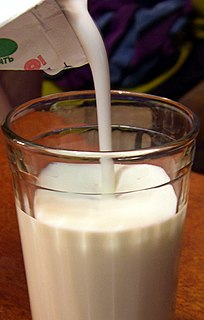Related Research Articles
Levilactobacillus brevis is a gram-positive, rod shaped species of lactic acid bacteria which is heterofermentative, creating CO2, lactic acid and acetic acid or ethanol during fermentation. L. brevis is the type species of the genus Levilactobacillus (previously L. brevis group), which comprises 24 species (http://www.lactobacillus.ualberta.ca/, http://www.lactobacillus.uantwerpen.be/). It can be found in many different environments, such as fermented foods, and as normal microbiota. L.brevis is found in food such as sauerkraut and pickles. It is also one of the most common causes of beer spoilage. Ingestion has been shown to improve human immune function, and it has been patented several times. Normal gut microbiota L.brevis is found in human intestines, vagina, and feces.

Kefir, is a fermented milk drink similar to a thin yogurt or ayran that is made from kefir grains, a specific type of mesophilic symbiotic culture. The drink originated in the North Caucasus, in particular the Elbrus environs along the upper mountainous regions of Circassia, Karachay and Balkaria from where it came to Russia, and from there it spread to Europe and the United States, where it is prepared by inoculating the milk of cows, goats, or sheep with kefir grains.
Lactiplantibacillus paraplantarum is a rod-shaped species of lactic acid bacteria first isolated from beer and human faeces. It is facultatively heterofermentative. Strain CNRZ 1885 is the type strain.

Lactobacillus johnsonii is a species in the genus Lactobacillus identified in 1980 by John L. Johnson, an American microbiologist and his associates. Its type strain is ATCC 33200. It is part of the healthy vaginal microbiota and has been identified as having probiotic properties. The L. johnsonii strain La1 was one of the first cultures to be proposed as a probiotic dairy supplement in 1995 at the Nestlé Research Center, Lausanne. Although yeast and bacteria have been used in dairy products for fermenting purposes for centuries, the investigation and choice of a microorganism as a fermenting agent based on its health benefits was novel at the time. Today the probiotic culture is used in the LC1 yogurt products by Nestlé.
Methanocalculus halotolerans is a species of archaeon, the type species of its genus. It is an irregular coccoid hydrogenotrophic methanogen. Its type strain is SEBR 4845T.
Cohnella thermotolerans is the type species of the bacterial genus Cohnella. It is Gram-positive, rod-shaped and endospore-forming, with type strain CCUG 47242T.
Bacillus aerius is a species of bacteria first isolated from cryogenic tubes used for collecting air samples from high altitudes, hence its name. Its type strain is 24KT.
Roseivivax halodurans is a species of bacteria, the type species of its genus. It is aerobic and bacteriochlorophyll-containing, first isolated from the charophytes on the stromatolites of a saline lake located on the west coast of Australia. It is chemoheterotrophic, Gram-negative, motile, rod-shaped and with subpolar flagella. Its type strain is OCh 239T.
Roseivivax halotolerans is a species of bacteria. It is aerobic and bacteriochlorophyll-containing, first isolated from the epiphytes on the stromatolites of a saline lake located on the west coast of Australia. It is chemoheterotrophic, Gram-negative, motile, rod-shaped and with subpolar flagella. Its type strain is OCh 210T.
Nocardioides aquaticus is a species of Gram-positive, non-motile and aerobic bacteria. Its type strain is EL-17KT.
Microlunatus lacustris is a species of Gram-positive, non-motile and aerobic bacteria. Its type strain is EL-17AT.
Deinococcus indicus is a species of arsenic-resistant bacterium. It is Gram-negative, rod-shaped, non-motile, non-sporulating and red-pigmented, with type strain Wt/1aT.
Lentibacillus salicampi is a moderately halophilic bacterium, the type species of its genus. It is Gram-variable, aerobic, endospore-forming and rod-shaped, with type strain SF-20(T).
Lentibacillus juripiscarius is an aerobic, spore-forming, Gram-positive, moderately halophilic bacteria, with type strain IS40-3T.
Streptococcus orisratti is a species of oral Streptococcus bacteria first isolated from Sprague–Dawley rats, hence its name. Its type strain is A63T.
Lactobacillus kefiranofaciens is a species of slime-forming, homofermentative, rod-shaped lactic acid bacteria first isolated from kefir grains, hence its name. Its type strain is WT-2B. Its genome has been sequenced.
Marinobacter bryozoorum is a marine, Gram-negative, aerobic and halophilic bacteria with type strain KMM 3840T.
Marinobacter sediminum is a marine, Gram-negative, aerobic and halophilic bacteria with type strain KMM 3657T.
Microbacterium dextranolyticum is a bacterium of the family Microbacteriaceae, with type strain IFO 14592.
Microbacterium aurum is a bacterium of the family Microbacteriaceae, with type strain IFO 15204.
References
- ↑ Takizawa, S.; Kojima, S.; Tamura, S.; Fujinaga, S.; Benno, Y.; Nakase, T. (1994). "Lactobacillus kefirgranum sp. nov. and Lactobacillus parakefir sp. nov., Two New Species from Kefir Grains". International Journal of Systematic Bacteriology. 44 (3): 435–439. doi: 10.1099/00207713-44-3-435 . ISSN 0020-7713.